Do you need a stylish coat to wear to work in the winter, but you aren’t sure what type of outerwear works best for you? Maybe you need to walk from the bus station to the office and you want a coat to keep you warm, or perhaps it rains all the time where you live and you a coat that will keep you dry. To help you pick the right coat, check out this guide to trench coat vs overcoat: what’s the difference?
The main difference between a trench coat and an overcoat is that a trench coat is a stylish raincoat for men and women, while an overcoat is a warm, formal winter coat for men and women. A trench coat features lightweight, water-resistant material and an overcoat contains heavyweight insulating material. A trench coat often has a shorter length than an overcoat as well.
In this article, you will discover the key differences between these popular coat styles. You will learn how an overcoat and trench cot compare to other types of outerwear. Finally, you will find the best overcoat and trench coat styles.
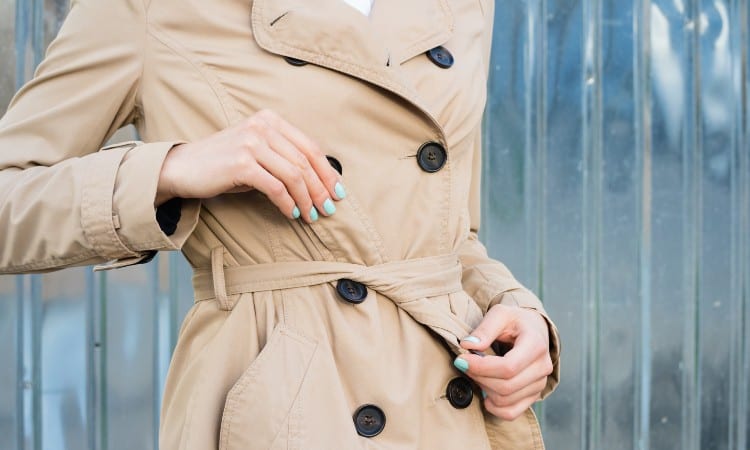
Trench Coat vs Overcoat: Key Points
| Trench Coat | Overcoat | |
|---|---|---|
| Fabric | Densely woven cotton or synthetics like gabardine | Heavyweight wool or synthetics |
| Length | Often knee-length, but can vary | Ofen full-length or three-quarters length, but can vary |
| Cut | Features raglan sleeves and a belted waist | Often boxier in cut with set-in sleeves, though some modern styles feature a more tapered cut |
| Style Variations | Style variations include hooded or not hoodie,d lined or unlined, and waterproofed or water-resistant fabric | Overcoats come in many styles including the ulster, peacoat, and chesterfield. |
| Formality | Suitable for a business casual or semi-formal event | Suitable for any cold semi-formal, formal, or black tie event |
| Insulation | Inslating for chilly weather but not for deep winter freezes | Depending on the weight of the fabric, insulating even in extreme winter weather |
| Water Proof | Highly waterproof and often sued as a stylish raincoat | Not waterproof but often water-resistant when made from sheep's wool |
| Cost | Varies a lot, but a good-quality trench coat costs at least $500 | Varies a lot, but a good-quality overcoat costs at least $200 |
| Best For | Inclement weather or any work occasion that requires going outdoors | Cold weather commutes or attending any formal event in the winter |
What is a Trench Coat?
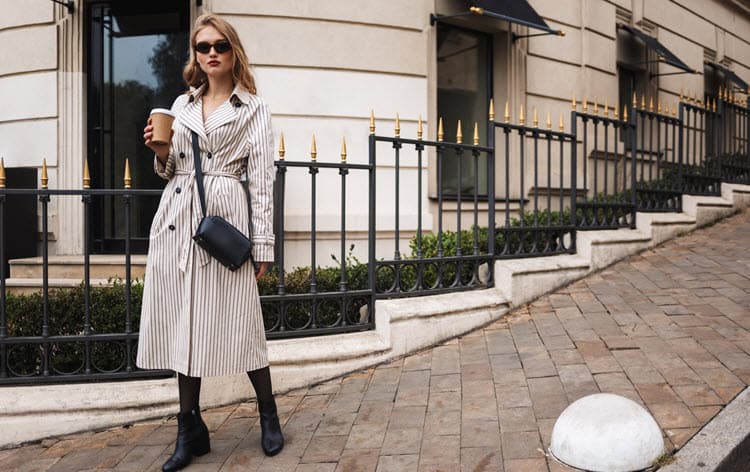
A trench coat is a stylish raincoat featuring water-resistant fabric, lapels, a foldover collar with hooks at the throat, and a fabric belt. Most trench coats have a variety of other common features, such as epaulets and an inner lining.
So, is a trench coat just a fancy raincoat? Many people wear a trench coat instead of a raincoat today, it’s true. But trench coats have their roots in military fashion, where they had a practical rather than aesthetic purpose.
Before World War I, the first trench-coat style garments came from an inventor and designer named Charles Macintosh, who developed a water-resistant, flexible cotton fabric to wear in the rain. (Some people still call their raincoats a “Macintosh” today!).
The late 1800s saw several advancements in semi-waterproof fabric. In the 1850s, another famous designer, Thomas Burberry, invented a new water-resistant fabric called gabardine, which intertwines waterproofed yarns in the weave of the fabric. This medium-weight, durable fabric quickly became a popular choice for outerwear.
The most iconic trench coat style also came from the Burberry company, and you can still buy a Burberry trench coat now–if you can afford it!
But, of course, the trench coat gets its name from the tragic circumstances of World War I. While never an official part of a military uniform, the practical garment quickly became a favorite among officers who would wear it over a uniform to stay dry in the muddy trenches.
In fact, the landscape of WWI is the reason trench coats traditionally feature khaki-colored gabardine, as this blended in with the colors of the bombarded trenches to provide camouflage.
These military trench coats had several features to help protect their wearers. First, they had hooks and eyes at the throat so the coat could close all the way up. Second, they had a generous length, reaching past the knee to provide lots of waterproofing without hanging long enough to become a tripping hazard in close spaces.
Trench coats at this time also often styled the shoulder flap and back cape that remain popular today for extra waterproofing. Plus, they came with D-rings, small metal loops in the shape of the letter D, sewn into the belt area. This allowed officers to attach tools like a flashlight, canteen, gas mask, or grenades to the outside of the garment for easy access.
Like many elements of the war, trench coats reached mass popularity because of Hollywood. If you have ever seen the iconic film Casablanca starring Humphrey Bogart, you probably remember his classy trench coat!
What is an Overcoat?

An overcoat is a warm winter coat in a formal style featuring heavy, soft fabric like wool or camel hair. Overcoats always have a fairly long length ranging from hip-length to ankle-length. The purpose of this outerwear style is to cover your indoor clothes and keep them clean and dry as you travel through messy winter weather outside.
Technically, the term “overcoat” encompasses many types of outerwear designed to go over the top of your indoor outfit. Other types of coats, such as peacoats and trench coats, are specific types of overcoats. But when you call a coat an overcoat today, you typically mean a long, formal wool coat designed to wear over the top of a business suit.
Overcoats have existed in one form or another for more than five hundred years. Upper-class men wore long, caped overcoats while traveling because mud would splash onto them while horseback riding or carriage driving.
When the middle class emerged, office workers adopted this style of all-encompassing outerwear for walking through the city to get to work, so passing cars would not splash mud and water onto their suits. Before synthetic fabrics and fast fashion, people owned very few sets of clothes and needed to work hard to keep them nice.
The type of heavy fabric used in overcoats can vary, coming in many different weaves like tweed, wool gabardine, or wool serge. But all overcoats contain underlining elements between the heavy wool and the inner lining to provide structure and add warmth.
Overcoats also feature a variety of popular cuts and styles, including single and double-breasted styles. Single-breasted coats have one row of buttons and double-breasted coats have two rows of buttons. Men’s coats fasten on the right side of the coat, and women’s overcoats fasten on the left side of the coat.
Most overcoats have a notched lapel that folds flat to either side of the opening rather than a stand-up collar, though styles vary.
What is the Difference Between Trench Coat and Overcoat?
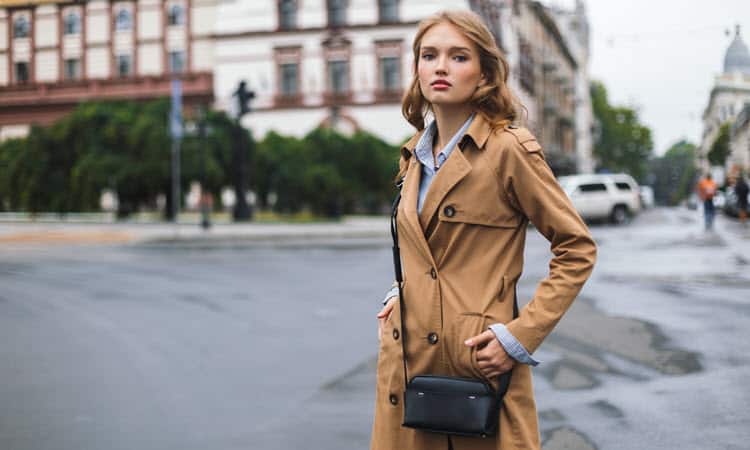
The main difference between trench coats and overcoats is that trench coats contain waterproof fabric and overcoats feature heavy, warm fabric. Both garments serve as outerwear meant to protect your clothing from the elements, but a trench coat makes a better choice for protection in rainy weather and an overcoat will keep you warmer in cold weather.
Fabric
One of the main differences between overcoats and trench coats lies in the type of fabric used to construct each type of outerwear. Overcoats commonly use three layers of fabric: warm wool for the outer layer, canvas or horsehair fabric for interlining, and silk or synthetic fabric for the lining. Trench coats feature a water-resistant fabric such as gabardine for the outer lining and silk or synthetic fabric for the inner lining.
When you handle the fabrics used in each coat type, the wool in an overcoat will feel soft, plush, and a little fuzzy. The gabardine in an overcoat will feel smooth, firm, and crisp beneath your hand.
Another way to think about the differences between these two types of fabrics is to consider the weight of the material. The wool used for an overcoat usually comes in a weight of 18 to 30 oz. This means that one yard of the material weighs 18 oz or up to 30 oz. Every yard of cloth in your coat will weigh a little more than the average football!
The gabardine used in trench coats has a little heft to it, but it typically comes in a midweight range of 7 oz to 14 oz.
Length
Trench coats and overcoats can share a similar length because both styles of outerwear come in various lengths, such as mid-thigh, knee-length, or mid-calf.
Overcoats most commonly come longer, which keeps your legs warm and protects your suit from getting splashed as you walk to lunch during your work day!
Trench coats most commonly end right below the knee. This length allows the belt at the waist to divide the garment neatly in half, balancing the top and bottom portions pleasingly.
Cut
Both trench coats and overcoats provide a roomy cut that allows you to wear the garment over the top of your suit jacket. When you look for a trench coat or overcoat that fits you well, try it on while wearing a suit jacket or blazer, and make sure the armholes comfortably fit over the shoulders of your suit.
That said, the two types of coats also feature some differences in the cut. Trench coats have a collar that can fold down or stand up to latch around the throat, using traditional hooks or the modern throat latch. Overcoats typically feature a long notched lapel instead, which does not come up to close around the throat.
Trench coats and overcoats also typically feature different sleeve styles. Trench coats typically use a sleeve style called a raglan sleeve, where the sleeve attaches in a diagonal line from the armpit to the collar. This provides greater mobility and is one of the reasons trench coats worked so well in a military setting.
Overcoats, in contrast, more typically use a set-in sleeve, where the circle of the sleeve attaches at the end of the shoulder.
Style Variations
Both trench coats and overcoats can feature several style variations.
Trench coats almost always have a back cape, shoulder epaulets, and a wide belt made from the same material as the coat. Aside from those elements, you can find quite a few style variations.
- Hooded trench coats that have a detachable hood that snaps onto the back of the collar
- Trench coats can come in light, unlined, or heavier-lined styles.
- Trench coats can come in many different colors, like navy blue and red, as well as the traditional khaki shade.
- Some trench coats use an additional waterproofing layer over top of the fabric to make it even more rainproof.
Because of their long fashion history, overcoats come in many different styles. They all contain some type of heavy fabric, traditionally wool. Today you can also find cheaper versions that use synthetic fabric that looks and feels very much like wool.
- An Ulster typically features a wide fabric belt at the waist, meant to knot in place rather than buckle. Traditionally, this coat came from Ireland and featured Donegal tweed, but you can find it in many colors and wool weaves today.
- A Chesterfield is a rather old-fashioned style with a single-breasted cut and short, triangular lapels. It does not have a belt but often has a boxier shape overall.
- A Paletot is one of the most popular styles of overcoat, with wide, long lapels featuring deep points, a double-breasted front, and pockets. It does not have a belt and often comes in a full-length or three-quarters style.
Formality
Both trench coats and overcoats look more formal than most other types of outerwear, but an overcoat has a slightly more formal style than a trenchcoat.
You could wear a trench coat or an overcoat to the office to cover your suit. But if you need to attend a formal, traditional event such as a black-tie event, a funeral, or an evening wedding, you should choose an overcoat that complements the color of your suit or dress.
By today’s fashion standards, there is not a lot of reason that a trench coat should appear less formal than an overcoat, But historically, trench coats had a utilitarian background and overcoats had a more luxurious, upper-class background. That is why overcoats still have a more formal connotation today.
Insulation
An overcoat will always provide more insulation and warmth than a trench coat. Trench coats use a lighter fabric designed to repel moisture rather than trap body heat. Most trench coats contain a lining material and the outer gabardine or densely woven twill fabric, but this typically provides about as much insulation as a rain jacket.
An overcoat uses heavyweight wool as its outer layer and often contains at least one inner layer. These fabric types contain many small fibers that will catch and hold pockets of warm air, keeping you toasty even on a dark winter day. Plus, the heavy weight of the material blocks drafts and bursts of snow from getting to your clothes.
Waterproof
A trench coat offers much greater water resistance than an overcoat. That said, both garments can easily protect you from a light sprinkle of rain or snow.
Most trench coats contain a special water-resistant fabric called gabardine, which uses tightly woven coated threads to make a dense material that resists moisture.
Unless you buy a version with a special waterproof layer applied to the outside of the garment, the fabric in your trench coat is probably not entirely waterproof. Other features on the trench coat, such as its back capelet and storm flaps at the shoulders, help to make sure any moisture just slides away instead of soaking through the fabric.
An overcoat does not use a special weave or a top layer to make it waterproof. However, the sheer thickness of the material does provide decent protection from moisture, at least for a limited time. Plus, if you get one made from real wool, the lanolin in the fibers will help repel moisture and keep you dry for longer.
Cost
The cost of trench coats and overcoats can vary greatly depending on the brand and the quality of materials used.
Trench coats can cost as little as $75 or as much as $2,000. Overcoats can cost anywhere from $60 to over $1,000. Of course, prices can go up even higher if you buy a bespoke version made to your precise measurements!
If you buy a trench coat or overcoat from a reputable brand using natural fabrics rather than synthetics, you can expect to pay at least $300 for an overcoat and at least $500 for a trench coat. Brands like Hugo Boss and Burberry sell coats priced at $1,000 and $2,000, too.
Best For
A trench coat is best for a business casual or semi-formal event when you expect chilly winds or rain. An overcoat is best for semi-formal or formal events in cold weather.
For example, you could easily wear a trench coat on your commute to work, especially on a day with bad weather. But you should wear an overcoat to work if you plan to take your boss to lunch that afternoon!
You should wear both of these garments over the top of your regular clothes and take off the coat when you move to an indoor setting.
Overcoat vs Peacoat

The distinction between an overcoat and a peacoat is that, technically, a peacoat is a type of short overcoat. An overcoat can come in many lengths and styles, but a peacoat always has a short length.
A peacoat is a wool coat ending at the hip, usually in a double-breasted style with two rows of buttons.
Traditionally, peacoats came in navy blue wool because they originated as part of the Dutch naval uniform in the 1800s. The Dutch word for heavy wool is “pije,” which eventually morphed into the English “pea.”
You can still find peacoats in this rather boxy, militaristic style today. You can also find more tapered styles made in a range of lighter or heavier fabrics more suitable for the modern gentleman or lady!
Greatcoat vs Trench Coat
The main difference between a greatcoat and a trench coat is that a greatcoat is much heavier and warmer than a trench coat.
A greatcoat is an old-fashioned type of overcoat that you don’t often see these days. It has a full-length cut and can come in double or single breast style. The key distinguishing feature of a greatcoat, besides its generous size and length, is that it always features very heavyweight fabric.
In the past, these super heavy wool garments could protect you from all kinds of inclement weather and keep your clothes nice. Since most people owned very few sets of clothing, protecting them mattered much more than it does now!
Today, most people who live in cold climates have heated cars and homes and do not have to ride on horseback to get from one place to another or work in an unheated office as people did in the past. This has made the extremely insulating greatcoat more or less a thing of the past.
That said, you can still buy great coats from some companies and if you live in a super cold part of the world, you may still consider this garment a necessary part of your daily work wear!
Overcoat vs Long Coat
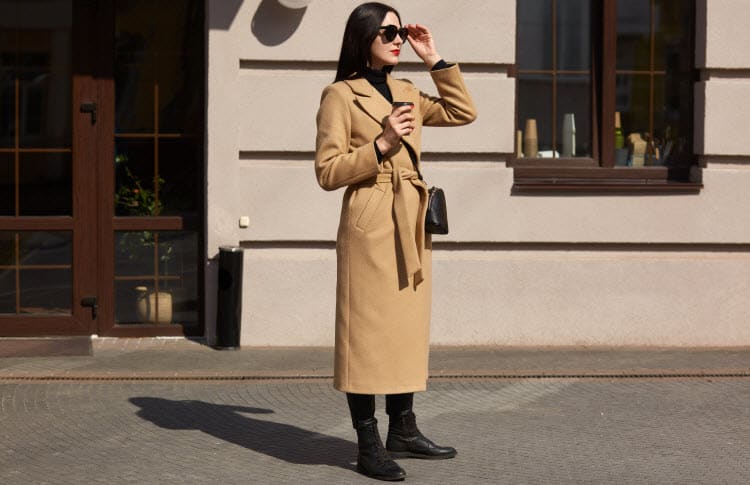
The difference between an overcoat and a long coat is that an overcoat is one type of long coat, but the term “long coat” can also mean many other styles of outerwear.
A coat simply means any type of outerwear longer than waist length, covering types of outerwear such as a raincoat, a trench coat, an overcoat, or a peacoat.
Many different coats can come in long lengths, and you can even buy full-length puffer coats to keep you insulated in cold weather!
An overcoat is a formal coat usually made out of wool and often (though not always) in a long length, such as full length or three-quarters length.
Can You Wear a Trench Coat in Winter?
You can sometimes wear a trench coat in winter, but this depends on the winter temperatures where you live and on the type of trench coat you own.
For moderate winters or parts of the world that experience a rainy season instead of snow and ice, a trench coat makes a great option. If you regularly experience below-zero temps in winter, you should look for a heavier coat that can provide more insulation.
You can also wear a trench coat in winter more easily if you get a model with a lining or an insulating middle layer.
Many trench coats offer a better option to wear during the fall or on cool spring days, though.
Trench Coat vs Wool Coat
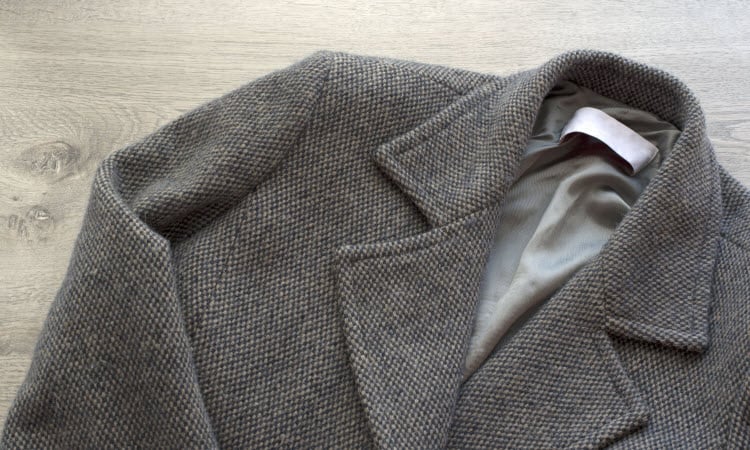
The main difference between a trench coat and any style of wool coat is that a trench coat protects the wearer from moisture, and the wool coat protects the wearer from cold.
Wool coats come in various styles, like overcoats, duffle coats, and peacoats. For hundreds of years, wool has remained one of the most popular materials for outwear.
Wool fibers have a lot of strength and durability. They can also absorb a ton of moisture, preventing water from soaking through to get your clothes beneath the coat. Plus, wool dries quickly, so you don’t have to worry about your coat mildewing after a rainstorm!
Of course, most importantly, wool offers amazing insulation. The heavier the weight of wool fabric in your coat, the more insulation it provides.
Conclusion
The key difference between a trench coat and an overcoat is that trench coats use midweight waterproof fabric and overcoats contain insulating wool fabric. Trench coats serve as elegant raincoats, perfect for any business casual or semi-formal event. Overcoats keep you warm in cold weather and look appropriate at any semi-formal or formal event.
Trench coats typically feature a back capelet and a wide fabric belt. Most overcoat styles do not use a belt and usually do not have a back cape. Both trench coats and overcoats can come in various lengths, but the most common length for a trench coat is knee length.
Have you ever invested in a nice trench coat or overcoat? What did you like about it? Leave a comment below to let us know!